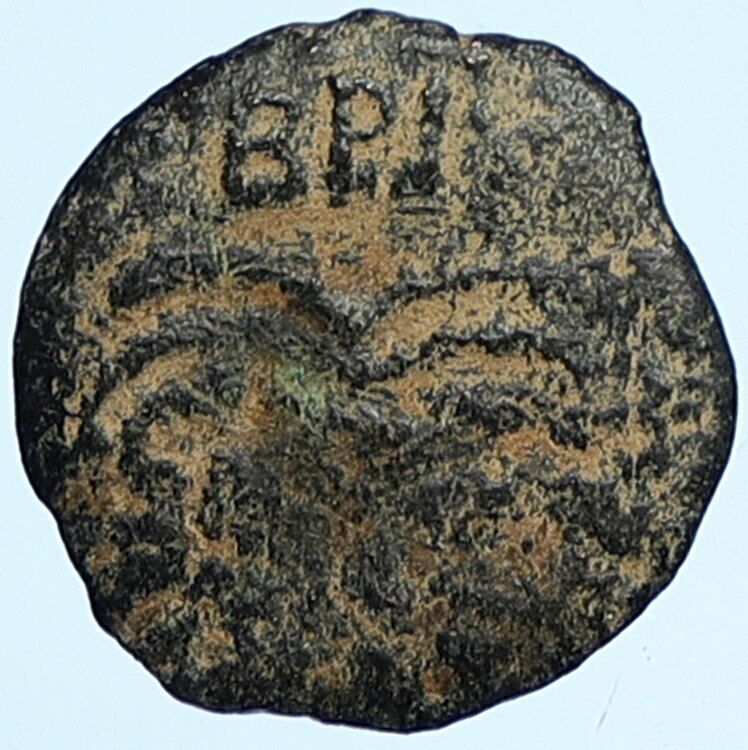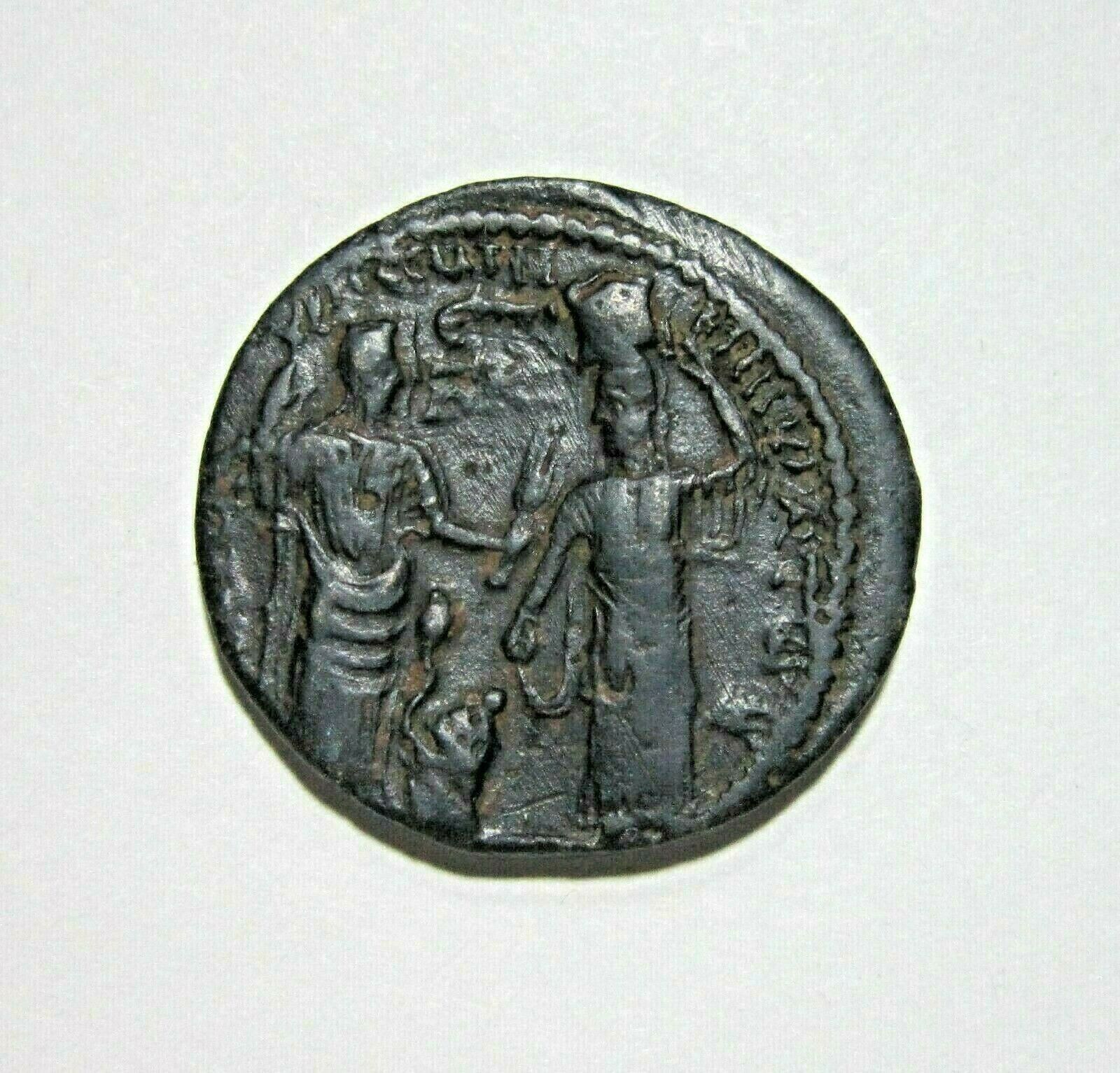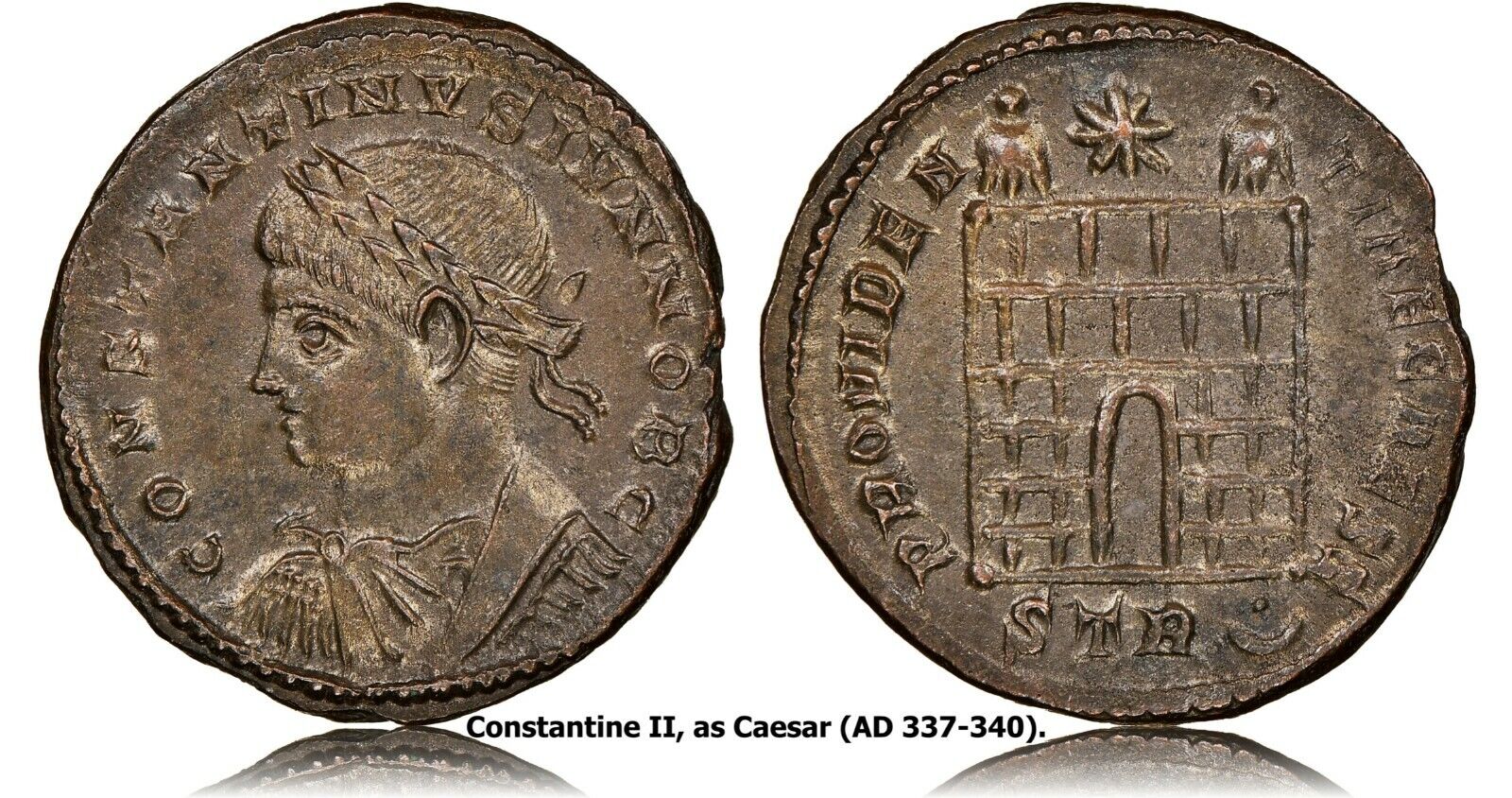-40%
CLAUDIUS Authentic Ancient 51AD MOPSUS CILICIA Old Roman Coin Tyche NGC i106731
$ 311.94
- Description
- Size Guide
Description
Item:i106731
Authentic Ancient Coin of:
Greek city of
Mopsos
in
Cilicia
Pseudo-autonomous Issue. Time of Claudius (41-54 A.D.)
Bronze 14mm Dated year 119, struck 51/52 A.D.
Reference: RPC I 4057.
Certification:
NGC Ancients
Ch VF 6156464-085
ΘΙΡ, Laureate head of Apollo right.
ΜΟΨΕΑΤΩΝ ΤΗΣ ΙΕΡΑΣ / KAI / AYTONOMOY, Artemis standing facing, head right, holding bow and drawing arrow.
Mopsos was situated on the river Pyramos, north-east of Mallos, the city was name after the brother of Amphilochos. During the reign of Antiochos IV of the Seleukid empire, it bore the name of Seleukeia.
You are bidding on the exact item pictured, provided with a Certificate of Authenticity and Lifetime Guarantee of Authenticity.
In Greek and Roman mythology,
Apollo
, is one of the most important and diverse of the Olympian deities. The ideal of the
kouros
(a beardless youth), Apollo has been variously recognized as a god of light and the sun; truth and prophecy; archery; medicine and healing; music, poetry, and the arts; and more. Apollo is the son of Zeus and Leto, and has a twin sister, the chaste huntress Artemis. Apollo is known in Greek-influenced Etruscan mythology as
Apulu
. Apollo was worshiped in both ancient Greek and Roman religion, as well as in the modern Greco-Roman Neopaganism.
As the patron of Delphi (
Pythian Apollo
), Apollo was an oracular god - the prophetic deity of the Delphic Oracle. Medicine and healing were associated with Apollo, whether through the god himself or mediated through his son Asclepius, yet Apollo was also seen as a god who could bring ill-health and deadly plague as well as one who had the ability to cure. Amongst the god's custodial charges, Apollo became associated with dominion over colonists, and as the patron defender of herds and flocks. As the leader of the Muses (
Apollon Musagetes
) and director of their choir, Apollo functioned as the patron god of music and poetry. Hermes created the lyre for him, and the instrument became a common attribute of Apollo. Hymns sung to Apollo were called paeans.
In Hellenistic times, especially during the third century BCE, as
Apollo Helios
he became identified among Greeks with Helios, god of the sun, and his sister Artemis similarly equated with Selene, goddess of the moon. In Latin texts, on the other hand, Joseph Fontenrose declared himself unable to find any conflation of Apollo with Sol among the Augustan poets of the first century, not even in the conjurations of Aeneas and Latinus in
Aeneid
XII (161-215). Apollo and Helios/Sol remained separate beings in literary and mythological texts until the third century CE.
Artemis
was one of the most widely venerated of the Ancient Greek deities. Some scholars believe that the name, and indeed the goddess herself, was originally pre-Greek. Homer refers to her as
Artemis Agrotera, Potnia Theron
"Artemis of the wildland, Mistress of Animals". In the classical period of Greek mythology, Artemis (Greek: (nominative) Ἄρτεμις, (genitive) Ἀρτέμιδος) was often described as the daughter of Zeus and Leto, and the twin sister of Apollo. She was the Hellenic goddess of the hunt, wild animals, wilderness, childbirth, virginity and young girls, bringing and relieving disease in women; she often was depicted as a huntress carrying a bow and arrows. The deer and the cypress were sacred to her. In later Hellenistic times, she even assumed the ancient role of Eileithyia in aiding childbirth.
Artemis later became identified with Selene, a Titaness who was a Greek moon goddess, sometimes depicted with a crescent moon above her head. She was also identified with the Roman goddess Diana, with the Etruscan goddess Artume, and with the Greek or Carian goddess Hecate.
Mopsuestia
(Greek: Μοψουεστία
Mopsou(h)estia
; Byzantine:
Mamista
,
Manistra
; Arabic:
al-Maṣṣīṣah
; Armenian:
Msis
,
Mises
,
Mam(u)estia
; Frankish:
Mamistra
) is an ancient city in Cilicia Campestris on the Pyramus River (now Ceyhan River) located approximately 20 km (12 mi) east of ancient Antiochia in Cilicia (present-day Adana, southern Turkey). From the city's harbour the river is navigable to the Mediterranean Sea, a distance of over 40 km (24 mi).
The founding of this city is attributed in legend to the soothsayer Mopsus, who lived before the Trojan war, although it is scarcely mentioned before the Christian era. Pliny the Elder calls it the free city of
Mopsos
(
Hist. nat.
, V, 22), but the ordinary name is Mopsuestia, as found in Stephanus of Byzantium and all the Christian geographers and chroniclers. Under the Seleucid Empire, the city took the name of
Seleucia on the Pyramus
(classical Greek: Σελεύκεια πρὸς τὸν Πύραμον,
Seleukeia pros ton Pyramon
; Latin:
Seleucia ad Pyramum
), but gave it up at the time of the Roman conquest; under Hadrian it was called
Hadriana
, under Decius
Decia
, etc., as we know from the inscriptions and the coins of the city. Constantius II built there a magnificent bridge over the Pyramus (Malalas,
Chronographia
, XIII; P.G., XCVII, 488) afterwards restored by Justinian (Procopius,
De Edificiis
, V. 5) and has been restored again recently.
Christianity seems to have been introduced very early into Mopsuestia and during the 3rd century there is mention of a bishop, Theodorus, the adversary of Paul of Samosata. Other famous residents of the early Christian period in the city's history include Saint Auxentius (d. 360), and Theodore, bishop from 392�"428, the teacher of Nestorius. The bishopric is included in the Catholic Church's list of titular sees. Along with much of Cilicia, the region was wrested from Roman control by the Arabs in the late 630s.
In 684 the Emperor Constantine IV recaptured Misis from its small Arab garrison and it remained an imperial possession until 703 (Theophanes, "Chronogr.", A. M. 6178, 6193), when it was recaptured by ̔the Arabs, who rebuilt the fortifications, constructed a mosque, and maintained a permanent garrison. Because of its position on the frontier, the city was repeatedly fought over and was recaptured from time to time by the Byzantines: it was besieged in vain by the Byzantine troops of John I Tzimisces in 964, but was taken the following year after a long and difficult siege by Nicephorus Phocas.
Mopsuestia then numbered 200,000 inhabitants, some of whom were Muslim, and the Byzantines made efforts to re-Christianize the city. In the early 1090s Turkish forces overran the town, but were expelled in 1097 by Crusader troops under Tancred who took possession of the city and its strategic port, which were annexed to the Principality of Antioch. It suffered much from internecine war between Crusaders, Armenians, and Greeks who lost it and recaptured it, notably in 1106, 1132, and 1137. Finally in 1151-52 the Armenian Baron T'oros II captured the city and defeated the Greek counter attack led by Andronikos I Komnenos. Thereafter it remained a possession of the Armenian Kingdom of Cilicia, but was briefly captured and plundered by the Mamluks in 1266, 1275, and 1322. The Venetians and Genoese were licensed by the Armenians to maintain warehouses near the harbour to store goods brought from India. The Armenians were permanently evicted by the Mamluks in 1347. The city was the site of several church councils and possessed four Armenian churches; the Greek diocese still existed at the beginning of the fourteenth century (Le Quien,
Oriens Christianus
, II, 1002 ). In 1432 the Frenchman Bertrandon reported that he city was ruled by the Muslims and was largely destroyed. In 1515 Mopsuestia, and the whole of Cilica, was incorporated into the Ottoman Empire by Sultan Selim I. Since then it has steadily declined and became the small village of
Misis
. Misis was renamed
Yakapınar
in the 1960s. Only fragments of the medieval fortifications survive today. However, an etching of the circuit walls and towers was made in the mid-19th century. The Misis Mosaic Museum was founded in 1959 to exhibit the mosaics found in the area, including the famous "Samson Mosaic."
In antiquity,
Cilicia
was the south coastal region of Asia Minor and existed as a political entity from Hittite times into the Armenian Kingdom of Cilicia during the late Byzantine Empire. Extending inland from the southeastern coast of modern Turkey, Cilicia is due north and northeast of the island of Cyprus and corresponds to the modern region of Çukurova in Turkey.
Frequently Asked Questions
Mr. Ilya Zlobin
, world-renowned expert numismatist, enthusiast, author and dealer in authentic ancient Greek, ancient Roman, ancient Byzantine, world coins & more.
Who am I dealing with?
You are dealing with Ilya Zlobin, ancient coin expert, enthusiast, author and dealer with an online store having a selection of over 15,000 items with great positive feedback from verified buyers and over 10 years experience dealing with over 57,000 ancient and world coins and artifacts. Ilya Zlobin is an independent individual who has a passion for coin collecting, research and understanding the importance of the historical context and significance all coins and objects represent. Most others are only concerned with selling you, Ilya Zlobin is most interested in educating you on the subject, and providing the largest selection, most professional presentation and service for the best long-term value for collectors worldwide creating returning patrons sharing in the passion of ancient and world coin collecting for a lifetime.
How long until my order is shipped?
Orders are shipped by the next business day (after receipt of payment) most of the time.
How will I know when the order was shipped?
After your order has shipped, you will be left positive feedback, and that date could be used as a basis of estimating an arrival date. Any tracking number would be found under your 'Purchase history' tab.
USPS First Class mail takes about 3-5 business days to arrive in the U.S. International shipping times cannot be estimated as they vary from country to country.
Standard international mail to many countries
does not
include a tracking number, and can also be slow sometimes.
For a tracking number and signature confirmation, you may want to do Express Mail International Shipping, which costs more, however, is the fastest and most secure. Additionally you may be able to receive your order in as little as 3-5 business days using this method. For Express Mail International, it may be possible to place up to 10-15 items in one package (for the one shipping cost) as it is flat rate envelope, which may be the most cost-effective, secure and fastest way to receive items internationally. Send me a message about this and I can update your invoice should you want this method.
Getting your order to you, quickly and securely is a top priority and is taken seriously here.
Great care is taken in packaging and mailing every item securely and quickly.
Please be aware, I cannot take responsibility for any postal service delivery delays, especially for international packages as it may happen in rare instances.
What is a certificate of authenticity and what guarantees do you give that the item is authentic?
Each of the items sold here, is provided with a Certificate of Authenticity, and a Lifetime Guarantee of Authenticity, issued by a world-renowned numismatic and antique expert that has identified over 57,000 ancient coins and has provided them with the same guarantee. You will be very happy with what you get with the COA; a professional presentation of the coin, with all of the relevant information and a picture of the coin you saw in the listing. Additionally, the coin is inside it's own protective coin flip (holder), with a 2x2 inch description of the coin matching the individual number on the COA.
On the free-market such a presentation alone, can be considered a - value all in itself, and it comes standard with your purchases from me,
FREE.
With every purchase, you are leveraging my many years of experience to get a more complete context and understanding of the piece of history you are getting. Whether your goal is to collect or give the item as a gift, coins presented like this could be more prized and valued higher than items that were not given such care and attention to.
Buy a coin today and own a piece of history, guaranteed.
Is there a money back guarantee?
I offer a 30 day unconditional money back guarantee. I stand behind my coins and would be willing to exchange your order for either store credit towards other coins, or refund, minus shipping expenses, within 30 days from the receipt of your order. My goal is to have the returning customers for a lifetime, and I am so sure in my coins, their authenticity, numismatic value and beauty, I can offer such a guarantee.
When should I leave feedback?
Once you receive your order, please leave a positive feedback. Please don't leave any negative feedbacks, as it happens sometimes that people rush to leave feedback before letting sufficient time for their order to arrive. Also, if you sent an email, make sure to check for my reply in your messages before claiming that you didn't receive a response. The matter of fact is that any issues can be resolved, as reputation is most important to me. My goal is to provide superior products and quality of service.
How and where do I learn more about collecting ancient coins?
Visit the
"Guide on How to Use My Store"
for on an overview about using my store, with additional information and links to all other parts of my store which may include educational information on topics you are looking for.













